What Is Lightweight Concrete | Properties of Lightweight Concrete | Uses of Lightweight Concrete | Advantages & Disadvantages of Lightweight Concrete
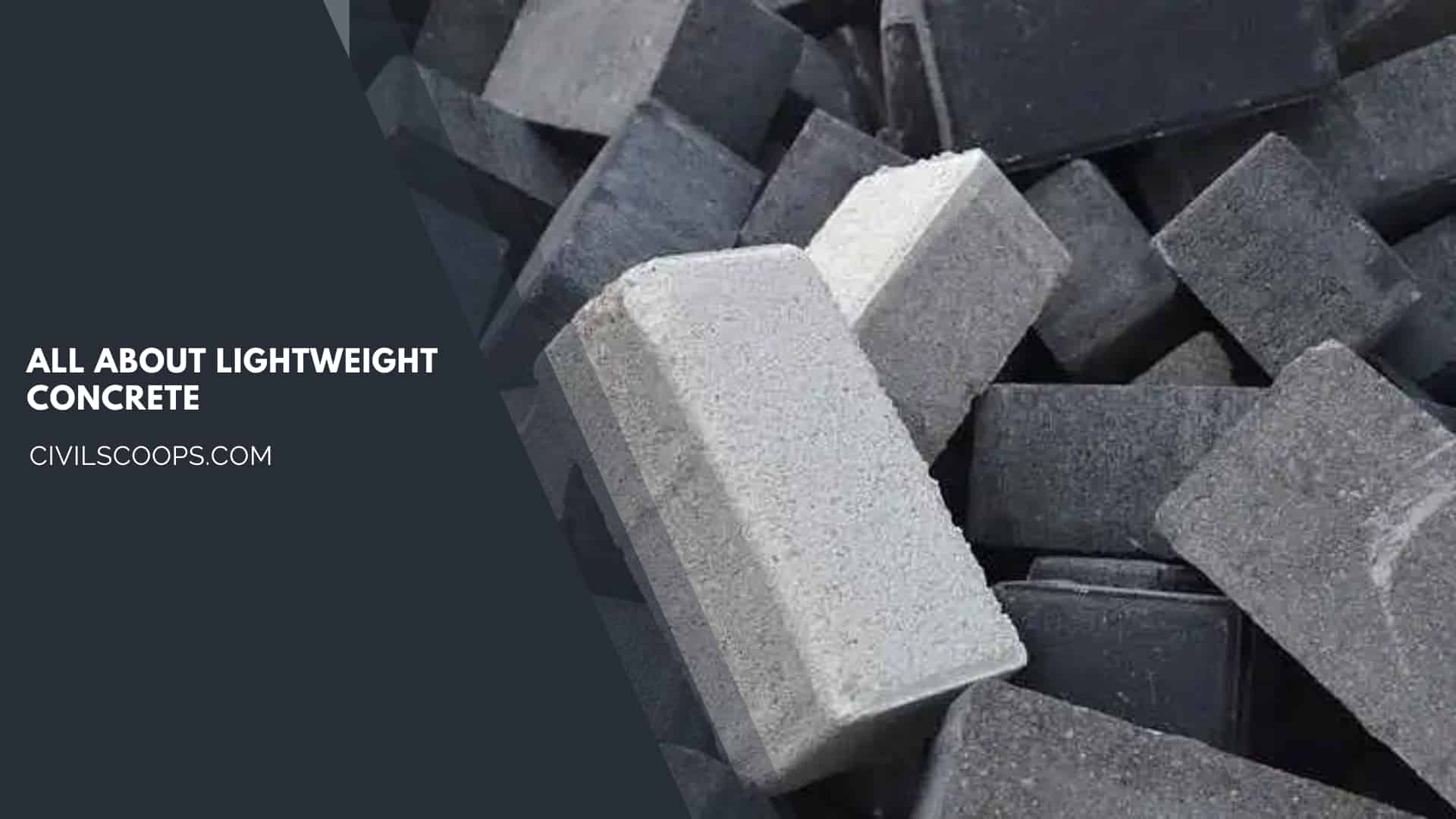
Table of Contents
What Is Lightweight Concrete?

Lightweight concrete can be defined as a type of concrete that includes an expanding agent in that it increases the volume of the mixture while giving additional qualities such as nailbility and lessened the dead weight. The main specialties of lightweight concrete are its low density and thermal conductivity.
Lightweight Aggregate Concrete:
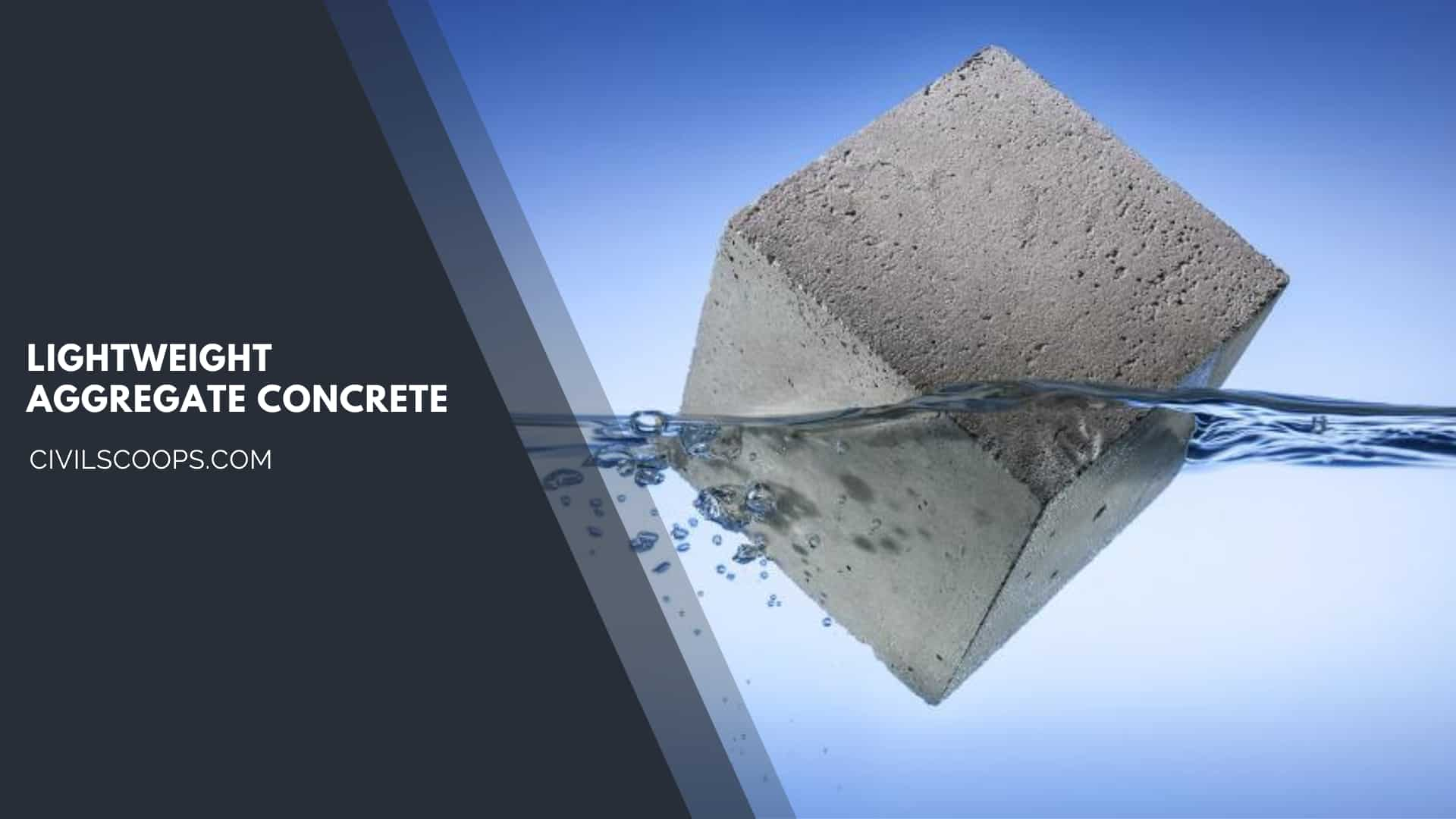
Lightweight Aggregate Concrete is prepared using lightweight aggregates or low-density materials such as volcanic pumice, clay, slate, shale, scoria, tuff, and pellite.
Concrete is considered to be Lightweight Aggregate Concrete if the density is not more than 2200 kg/m3, compared to standard concrete which is 2300-2400 kg/m3 and a proportion of the aggregate, should have a density of less than 2000 kg/m3.
Properties of Lightweight Concrete:
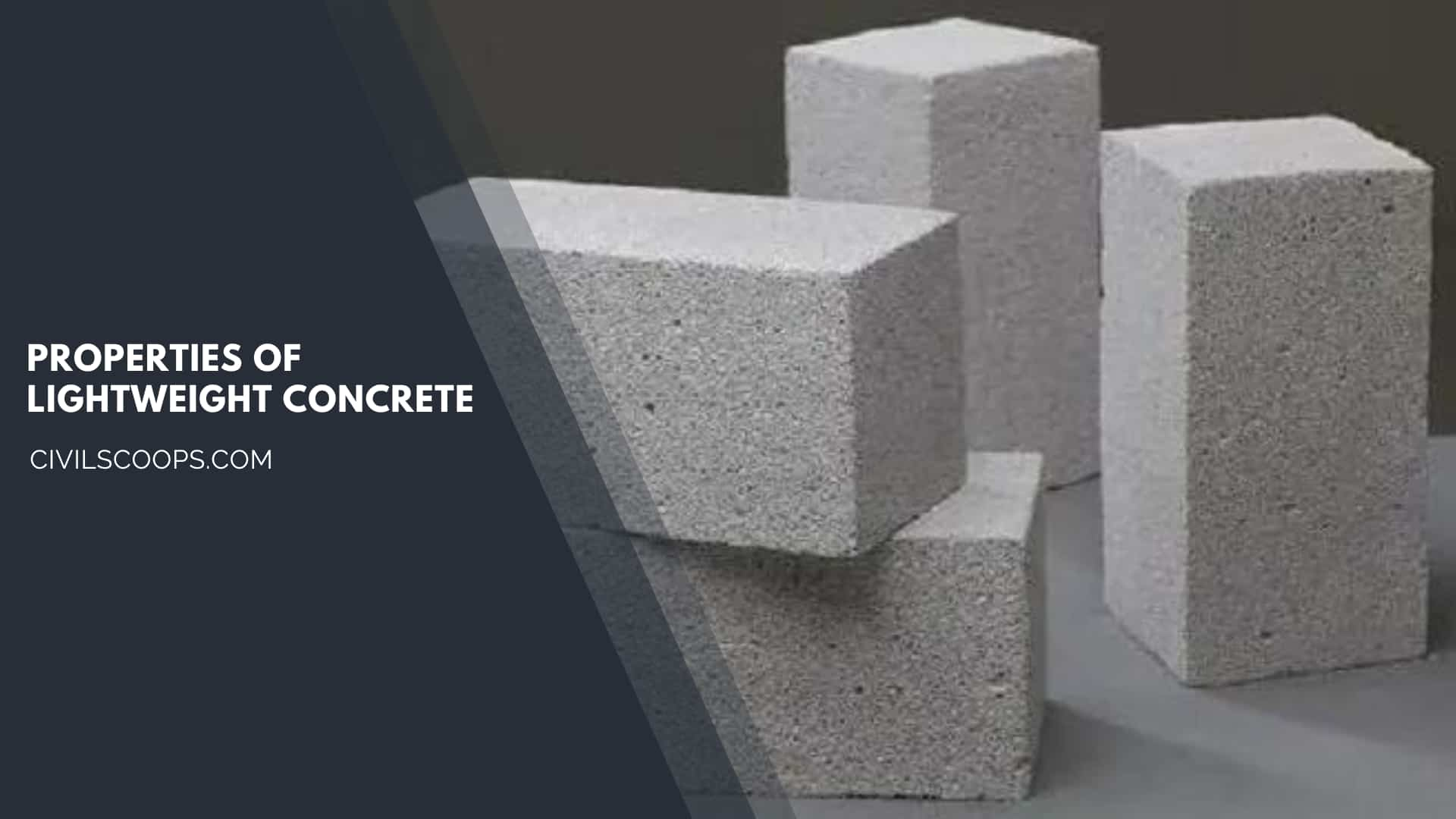
Properties that are shown by Lightweight Concrete are given below.
- The shape of the aggregates that are used in Lightweight Concrete may have a cubical, rounded, angular, or irregular shape.
- Textures of Lightweight Concrete may range from a very fine pore, very smooth skins to very irregular surfaces with large exposed pores.
- The shape of the particles and the texture of Lightweight Concrete can directly affect the workability, ratio of coarse to fine aggregate, the cement content requirements, and the demand for water in concrete mixtures.
- Compressive strength levels that are commonly required by the construction site for designing of cast-in-place, precast, or prestressed concrete is around 3,000 to 5,000 psi which can be easily obtained with Lightweight Concrete.
- The permeability of light-weight concrete was much lower and was generally equal to or significantly lower than reported by standard weight concrete.
- Aggregates batched with a high degree of saturation can be replaced by standard weight aggregates to provide internal curing in Lightweight Concrete which contains a high volume of cementitious materials.
- The reason is the better hydration of the cement part provided by the moisture found from the slowly released reservoir of water absorbed within the pores of the lightweight aggregates.
- The thermal conductivity of concrete depends largely on its density and moisture content but also on the size and distribution of pores, the chemical composition of solid components, and the internal structure of lightweight concrete.
- Since lightweight concrete is relatively low in density and the moisture content is high due to the pores, the thermal conductivity of this concrete is less than that of conventional concrete.
- When tested in accordance with ASTM E 119 procedures, structural lightweight concrete slabs, walls, and beams have shown a greater fire tolerance period than members of equal size made of concrete containing standard aggregates.
Also Read: Definition Efflorescence | Efflorescence in Concrete
Useful Article for You
- What Is a Highway Flyover
- What Is Grouting
- What Is a Pile Cap
- What Is a Bond Beam in Masonry
- What Is Sapwood
- What Is Crane
- What Is a Gable
- What Is Superelevation
- What Is Kerb
- What Is the Purpose of Washers
- What Is the Size of a Brick in Inches
- What Is Reinforced Masonry
- What Is Workability
- What Is Bond Breaker
- What Is Plasticizer in Concrete
- What Is Luminous Flux Vs Lumens
- What Is Caisson
- What Is an Undercoat
- What Is a Benchmark Surveying
- What Is Bracing in Construction
- What Is a Beam in Construction
- What Is the Standard Door Frame Size
- What Is a Spandrel Beam
- What Is a Fire Escape
- What Is a Weep Hole
- What Is Tie Beam
- What Is Fine Aggregate
- What Is Pony Wall
- What Is Flag Stone
- What Is Development Length
- What Is Cement Plaster
- What Is a Pitched Roof
- What Is a Slab in Construction
- What Is a Monolithic Slab
- What Is Linear Distance
- What Is Shovel
- What Is Lintel in Construction
- What Is a Concept Sketch
- What Is Mezzanine Floor
- What Is Man Sand
- What Is Plaster Made Out of
- What Is a Floating Slab
- What Is Falsework
- What Is Bituminous
- What Is a Spillway
- What Is Curb and Gutter
- What Is Dampness
- What Is Lap Length
- What Is the Full Form of Fsi
- What Is Door Frame
- What Is Plinth Protection
- What Is Traffic Rotary
- What Is Grade Slab
- What Is Inverted Beam
- What Is Rolling Margin of Steel
- What Is Modulus of Rupture
- What Is Fresh Concrete
- What Is Dpc in Construction
- What Is Earthen Dam
- What Is Plum Concrete
- What Is Shell Structure.
- What Is Lumber
- What Is the Strongest Foundation for a House
- What Is the Meaning of Soundness of Cement
- What Is Flyover Bridge
Uses of Lightweight Aggregate Concrete:
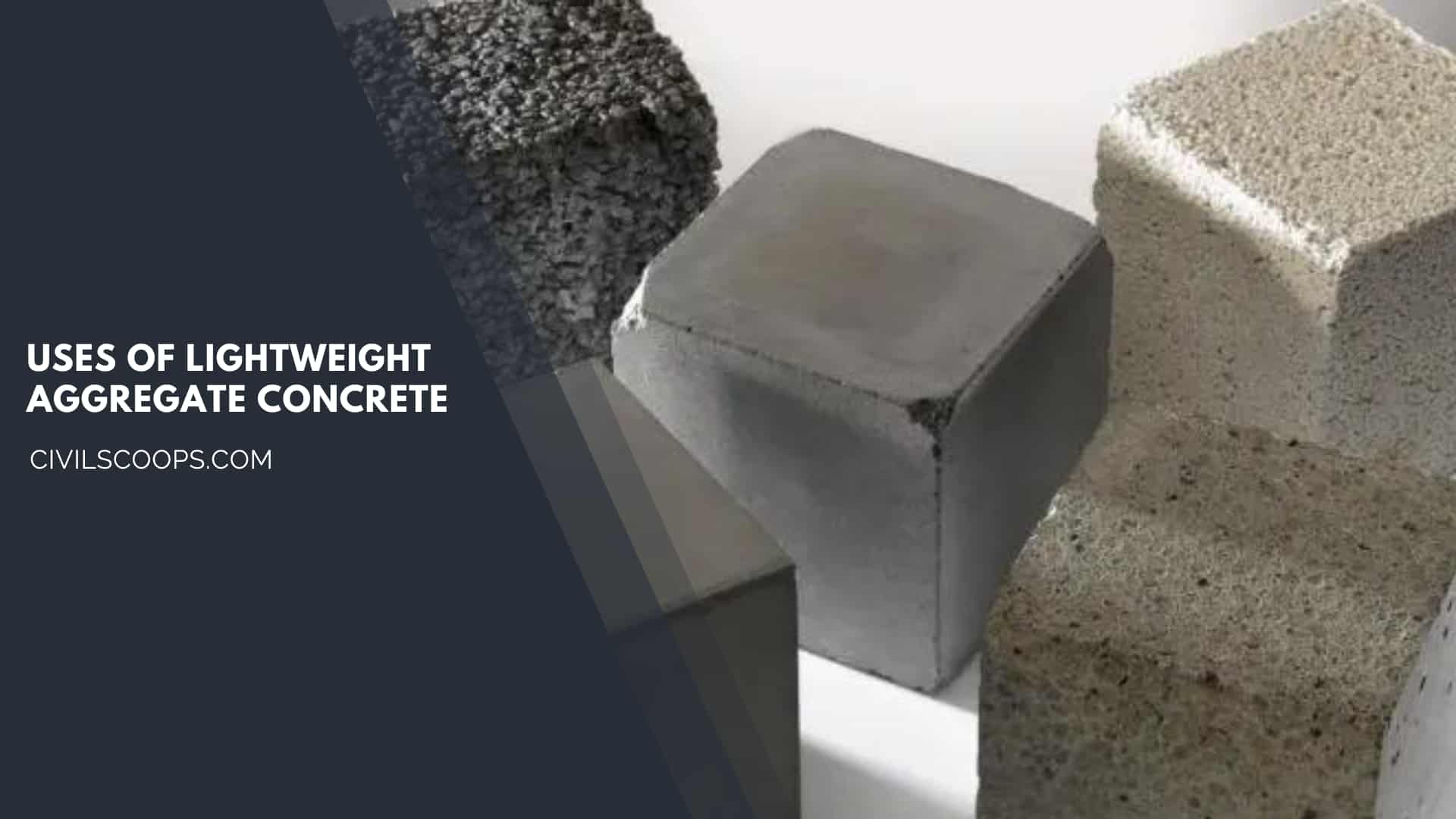
The following are the Uses of Lightweight Aggregate Concrete.
- Lightweight Aggregate Concrete are used as screeds and reinforcement for general purposes especially when screeds or similar thickening and the weight to the floor, roof, and other structural members of the building.
- Lightweight Aggregate Concrete is used as Screeds and walls where the timber has to be attached by nailing.
- Lightweight Aggregate Concrete is used as casting structural steel to protect against fire and corrosion or as a covering for construction purposes.
- Lightweight Aggregate Concrete is used as heat insulation on the roof.
- Lightweight Aggregate Concrete is used for insulating the water pipes.
- Lightweight Aggregate Concrete is used for the construction of partition walls and panel walls in frame structures.
- Lightweight Aggregate Concrete is used for brick fixing to get nails from joinery, especially in the construction of a home or domestic type construction.
- Lightweight Aggregate Concrete is used as typical wall insulation.
- Lightweight Aggregate Concrete is used for surface rendered for exterior walls of small houses.
- Lightweight Aggregate Concrete is also being used for reinforced concrete.
Also Read: Load-Bearing Vs Partition Walls | What Are Walls | Classified of Walls
Advantages of Lightweight Concrete:
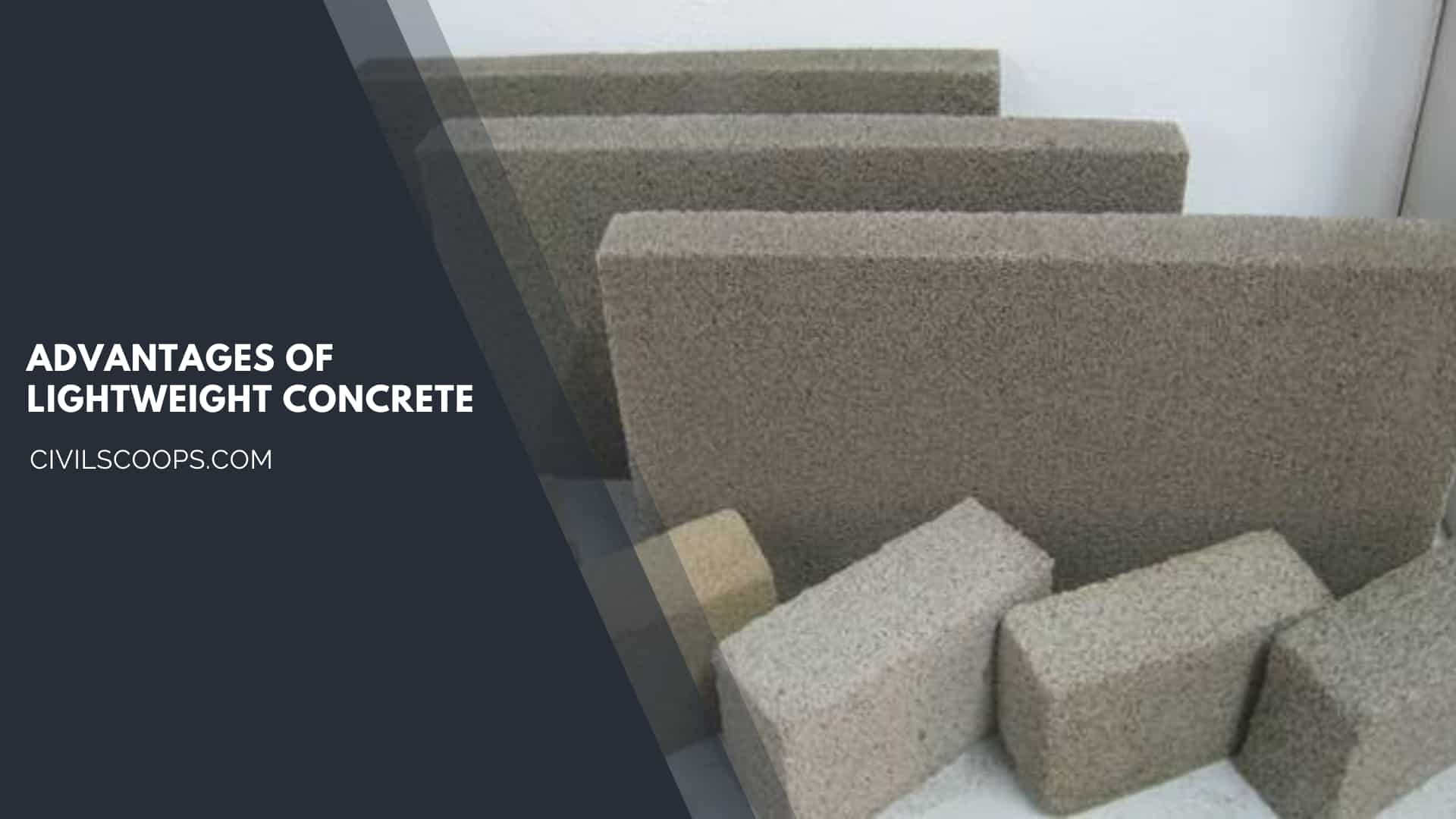
The following are the Advantages of Lightweight Concrete.
- Lightweight Concrete reduces the dead loads resulting in savings in foundations and reinforcement.
- Lightweight Concrete improves the thermal properties of a building.
- Lightweight Concrete improves the fire resistance of a building.
- Lightweight Concrete saves transportation and managing of precast units on site.
- Lightweight Concrete reduces the formwork and propping.
Useful Article for You
- How Wide Is a Cinder Block
- How Much Is a Coffered Ceiling
- How to Make Mortar
- How Long Does Hempcrete Last
- How to Use a Hand Sight Level
- How to Construction
- How to Build a Lean to Roof
- How Are Tunnels Built
- How to Layout a Building
- How Wide Is a Car Parking Space
- How Do Shear Walls Work
- How to Measure Concrete Slump
- How Are Bridge Foundations Built
- How to Use Washers with Screws
- How Dense Is Sand
- How High Is a Window from the Floor
- How to Fix Spalling Concrete Foundation
- How Does a Beam Bridge Work
- How Do They Pour Concrete Under Water
- How Does a Sewer System Work
- How High Are Countertops
- How to Seal Brick Wall Interior
- How to Resurface Cement
- How to Use Portland Cement
- How Is Plaster Made
- How to Find Fineness Modulus
- How to Get Rid of Spray Paint Smell on Metal
- How Many Types of Slope Are There
- How Big Is a Stair Landing
- How to Get Paint Off Concrete Without Chemicals
- How to Fix Water Damaged Drywall
- How Much to Get Septic Pumped
- How to Cut a Nail or Screw
- How Long Does Wet Concrete Take to Dry
- How Is Varnish Made
- How Does Ejector Pump Work
- How Does Hydrometer Work
- How to Get Wet Blood Out of Carpet
- How to Build House on Slope
- How Thick Is Plaster Wall
- How Suspension Bridges Work
- How to Seal a Concrete Roof
- How Was Cement Invented
- How to Calculate Area of Steel
- How to Check Silt Content in Sand
- How a Building Is Constructed
- How Are Roads Classified in India
- How Many Types of Cement in India
- How to Find Contour Interval
- How to Stop Leakage from Ceiling
- How Hardness of Brick Is Tested
- How Many Types of Paint Brushes Are There
- How to Calculate Skirting Area
- How Many Types of Beam
- How to Make Road
- How Many Types of Chain in Surveying
- How to Find One Way and Two Way Slab
Disadvantages of Lightweight Concrete:
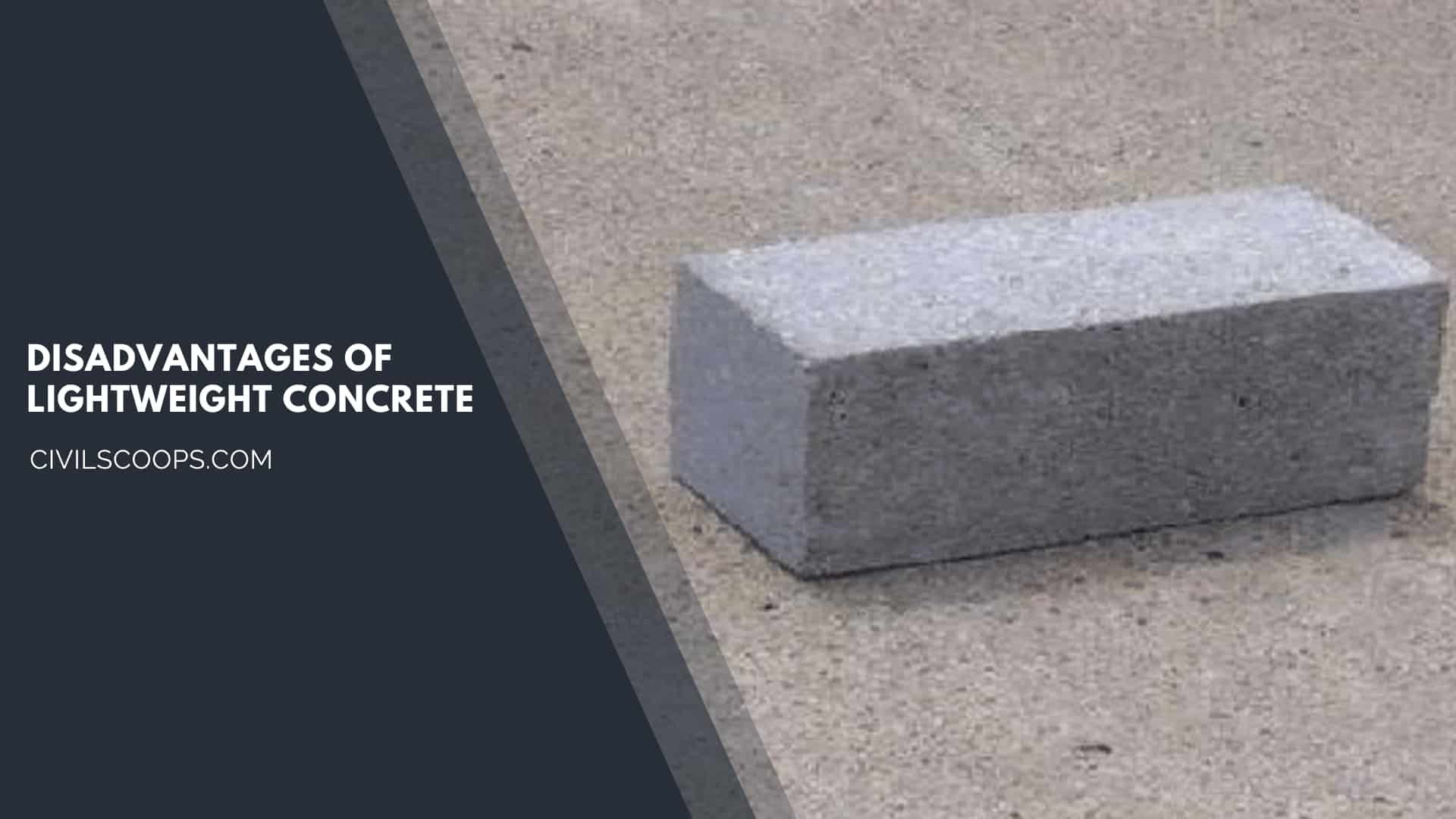
The only disadvantage of Lightweight Concrete is that the depth of carbonation that is, the depth at which corrosion can occur within the right conditions is almost twice that of conventional concrete.
Therefore, special care will need to be taken to provide adequate coverage to the reinforcement of the lightweight structures to grant protection against corrosion.
Also Read: What Is Rebar | Why use Reinforcement in Concrete | Types of Steel Reinforcement Bars
Lightweight Concrete Vs Conventional Concrete:
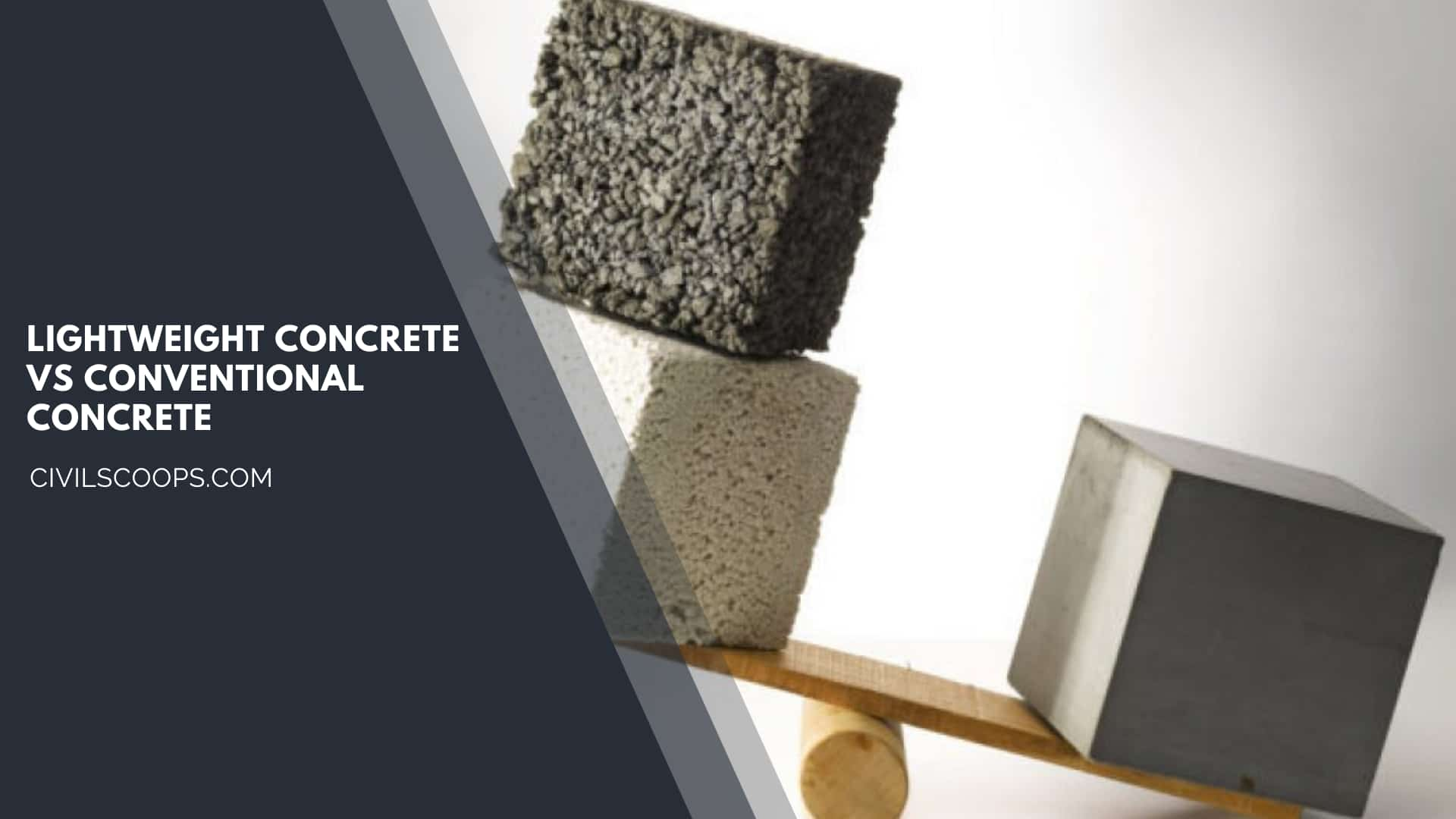
The following are the difference between Lightweight Concrete and Conventional Concrete.
- The weight of Lightweight Concrete is 20 to 115 pounds per cubic foot whereas the weight of Conventional Concrete is 130 to 150 pounds per cubic foot.
- The compressive strength of Lightweight Concrete is 7000 psi whereas the compressive strength of Conventional Concrete is 8000 psi.
- The modulus of Elasticity for Lightweight Concrete is 65000 psi for the ultra lightweight concrete, 3 million psi for the medium-lightweight concrete, where as the modulus of Elasticity is 2 to 6 million psi for the Conventional Concrete.
- The shrinkage of the aggregates of light weight concrete are, Perilite 0.1 to 0.2 %, Vermiculite 0.1 to 0.7 %, Slag 0.04 to 0.06 %, Slate and Clay 0.02 to 0.08 %, where as the shrinkage of the aggregates of conventional Concrete is around 0.04 to 0.08 %.
- The thermal conductivity of the aggregates of lightweight concrete is Perlite 0.1 to 0.2 %, Vermiculite 0.1 to 0.7 %, Slag 0.04 to 0.06 %, Slate and Clay 0.02 to 0.08 % BTU per hour per square foot per degree F, per inch, whereas the thermal conductivity of the aggregates of conventional Concrete is sand and gravel ranges from 8 to 12 %.
- The fire resistance for lightweight Concrete is a 4-hour rating for 4.5-inch slabs with lightweight concrete, whereas the fire resistance is a 3-hour rating for 6-inch slabs made of trap rock, crushed limestone, and gravel aggregates used in conventional Concrete.
[su_box title=”FAQ” style=”default” box_color=”#333333″ title_color=”#FFFFFF” radius=”3″ class=”” id=””]
What Is Lightweight Concrete?
Lightweight concrete is defined by BS EN 206-1 as having an oven-dry density of not less than 800kg/m3 and not more than 2000kg/m3 by replacing dense natural aggregates either wholly or partially with lightweight aggregates.
What Is Cellular Lightweight Concrete?
Lightweight cellular concrete (LCC) is a mixture of portland cement, water, and air created through a preformed foaming agent. LCC can act as a lightweight, strong, durable, and inexpensive soil or fill replacement for geotechnical applications.
What Is Lightweight Aggregate Concrete?
Lightweight aggregates are used to produce lower density concretes, which are advantageous in reducing the self-weight of structures and also have better thermal insulation than normal weight concrete. The lightweight of the aggregate is due to the cellular or highly porous microstructure.
Properties of Lightweight Concrete
The intrinsic properties of lightweight concrete (LWC) provides promising scope of using in structural purposes. Normal Weight Concrete has density 2400 kg/m3 whereas LWC produces density ranging from 1400 kg/m3 to 2000 kg/m3.
What Is Lightweight Concrete Used For?
Lightweight aggregate concretes can be used for structural applications, with strengths equivalent to normal weight concrete. The benefits of using lightweight aggregate concrete include: Reduction in dead loads making savings in foundations and reinforcement. Improved thermal properties.
How Is Lightweight Concrete Made?
Lightweight aggregate concrete is made with lightweight aggregates, either natural or manufactured, comprising gravel or crushed stone. Therefore it has substantially lower bulk density than concrete. Further, as many types of aggregates can be used, one can design concretes of required densities and strengths.
Is Lightweight Concrete More Expensive?
While it is true that lightweight concrete typically costs more on a per cubic yard basis than normal weight concrete, it can provide a more economical solution to a mid- or high-rise building.
How to Make Lightweight Concrete?
The method for making lightweight cement blocks comprises mixing three parts by volume sawdust with water to form a first mixture having a relative moisture content in the range of 40% to 44%, preferably 42%, adding one part by volume of sand to the first mixture to form a second mixture, mixing the second mixture with .
Lightweight Aggregate Concrete
A lightweight aggregate (LWA) is a solid substance having a particle density of less than 2.0 g/cm3 and a loose bulk density of less than 1.2 g/cm3 (BS EN 13055-1, 2002) [17]. LWAs are porous and granular materials that have been widely used in architecture, landscaping, and geotechnics [18].
How Much Does Concrete Weight?
Lite Weight Concrete
Lightweight concrete is a mixture made with lightweight coarse aggregates such as shale, clay, or slate, which give it its characteristic low density. Structural lightweight concrete has an in-place density of 90 to 115 lb/ft³, whereas the density of regular weight concrete ranges from 140 to 150 lb/ft³.
Advantages of Lightweight Concrete
The Advantages of Using Lightweight Concrete in Construction
- Reduced weight and increased ease of handling.
- Improved thermal insulation and fire resistance.
- Enhanced sound insulation and acoustic performance.
- Increased durability and resistance to weathering.
Disadvantages of Lightweight Concrete
Disadvantage of lightweight concrete
It is very sensitive with water content in mixture. Difficult to finish its surface due to porosity and hollow structure of aggregates. Lightweight concrete requires more time to assure proper mixing with compare to conventional or normal concrete.
Density of Lightweight Concrete
Whereas NWC weighs from 2240 to 2450 kg/m3, lightweight concrete weighs ∼300–2000 kg/m3, but the practical range of density for lightweight concrete is 500–1850 kg/m3.
Normal Weight of Concrete
The weight of concrete can vary depending on its composition and density. In general, the density of concrete is around 2400 kg/m³ (150 pounds per cubic foot). This means that a cubic meter (or a cubic yard) of concrete would weigh approximately 2400 kilograms (or 150 pounds times 27, which is 4050 pounds), assuming it’s made of standard ingredients.
[/su_box]
[su_note note_color=”#F2F2F2 ” text_color=”#333333″ radius=”3″ class=”” id=””]
Like this post? Share it with your friends!
Suggested Read –
- What Is Bridge Abutment
- Water Damage in Bathroom
- Specific Gravity Test of Bitumen
- What Is Zero Force Member for Truss
- Difference Between Flexible Pavement and Rigid Pavement
[/su_note]
Originally posted 2023-11-03 11:37:04.
